
André René Roussimoff, better known by his ring name André the Giant, was a French professional wrestler and actor. Dubbed "the Eighth Wonder of the World", Roussimoff was known for his great size, which was a result of gigantism caused by excess growth hormones.

WrestleMania IV was the fourth annual WrestleMania professional wrestling pay-per-view (PPV) event produced by the World Wrestling Federation. The event took place on March 27, 1988, at Boardwalk Hall in Atlantic City, New Jersey. The announced attendance of the event was 19,199.
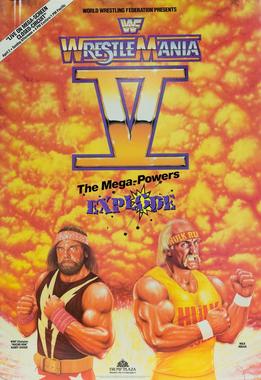
WrestleMania V was the fifth annual WrestleMania professional wrestling pay-per-view (PPV) event produced by the World Wrestling Federation. It took place on April 2, 1989, at the Boardwalk Hall in Atlantic City, New Jersey. A total of 14 matches were contested at the event.

WrestleMania VII was the seventh annual WrestleMania professional wrestling pay-per-view (PPV) event produced by the World Wrestling Federation. It took place on March 24, 1991, at the Los Angeles Memorial Sports Arena in Los Angeles, California in the United States. Fourteen matches were shown during the live broadcast, with one dark match held before the event.

WrestleMania VIII was the eighth annual WrestleMania professional wrestling pay-per-view (PPV) event produced by the World Wrestling Federation. It took place on April 5, 1992, at the Hoosier Dome in Indianapolis, Indiana in the United States. Nine matches were shown during the live broadcast, with one dark match occurring before the event.
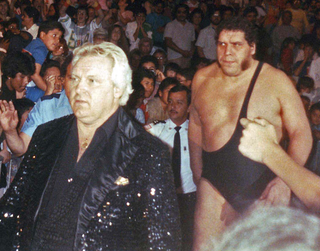
The Heenan Family was a stable of wrestlers managed by Bobby "The Brain" Heenan beginning in the 1970s. Heenan managed wrestlers under the Heenan Family name in the American Wrestling Association (AWA), the National Wrestling Alliance's (NWA) Georgia Championship Wrestling (GCW), and the World Wrestling Federation (WWF).

The Mega Bucks were a professional wrestling tag team that competed in the World Wrestling Federation (WWF) in 1988. The team, consisting of "The Million Dollar Man" Ted DiBiase and André the Giant, was formed in a storyline that saw DiBiase purchase André's contract from fellow manager Bobby Heenan. André was to win the WWF World Heavyweight Championship from Hulk Hogan, but then he attempted to sell the belt to DiBiase. The title was vacated, but DiBiase and André were then scheduled to face Hogan and Macho Man Randy Savage in a match at SummerSlam, which Hogan and Savage won. After the match, DiBiase and André went their separate ways and the team was dissolved.

The 1988 SummerSlam was the inaugural SummerSlam professional wrestling pay-per-view (PPV) event produced by the World Wrestling Federation. It took place on August 29, 1988, at Madison Square Garden in New York City, New York. The pay-per-view was created to help the company compete against rival promotion Jim Crockett Promotions. It was one of the first four annual pay-per-view events produced by the WWF, along with WrestleMania, the Royal Rumble, and Survivor Series, which were eventually dubbed the "big four".
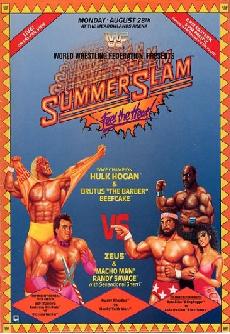
The 1989 SummerSlam was the second annual SummerSlam professional wrestling pay-per-view (PPV) event produced by the World Wrestling Federation. It took place on August 28, 1989, in the Meadowlands Arena in East Rutherford, New Jersey. Ten matches were contested at the event, including one dark match held before the live broadcast.

The 1990 SummerSlam was the third annual SummerSlam professional wrestling pay-per-view event produced by the World Wrestling Federation. It took place on August 27, 1990, at The Spectrum in Philadelphia, Pennsylvania. The card consisted of 10 televised matches, including two main events. The Ultimate Warrior successfully defended the WWF World Heavyweight Championship against Rick Rude in a Steel Cage match, and Hulk Hogan defeated Earthquake by countout.

The 1990 Royal Rumble was the third annual Royal Rumble professional wrestling pay-per-view (PPV) event produced by the World Wrestling Federation. It took place on January 21, 1990, at the Orlando Arena in Orlando, Florida. It centered on the Royal Rumble match, a modified battle royal in which participants enter at timed intervals instead of all beginning in the ring at the same time.

The 1989 Royal Rumble was the second annual Royal Rumble professional wrestling event produced by the World Wrestling Federation. After the inaugural event aired as a television special, the 1989 event aired on pay-per-view (PPV), thus becoming one of the WWF's original four annual PPV events, along with WrestleMania, SummerSlam, and Survivor Series, which would become recognized as the "Big Four". It took place on January 15, 1989, at The Summit in Houston, Texas. It centered on the Royal Rumble match, a modified battle royal in which participants enter at timed intervals instead of all beginning in the ring at the same time.

The 1987 Survivor Series was the inaugural Survivor Series professional wrestling pay-per-view (PPV) event produced by the World Wrestling Federation. It took place on Thanksgiving Night on November 26, 1987, and was held at the Richfield Coliseum in Richfield Township, Ohio. It was one of the first four annual pay-per-view events produced by the WWF, along with WrestleMania introduced in 1985 and Royal Rumble and SummerSlam introduced in 1988, referred to as the "Big Four".
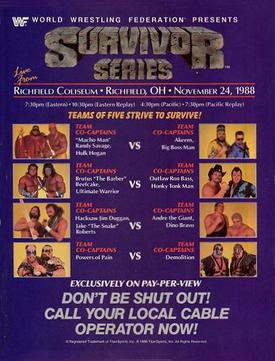
The 1988 Survivor Series was the second annual Survivor Series professional wrestling pay-per-view (PPV) event produced by the World Wrestling Federation. It took place on November 24, 1988, at the Richfield Coliseum, in Richfield Township, Ohio for the second consecutive year. Four matches were contested at the event.
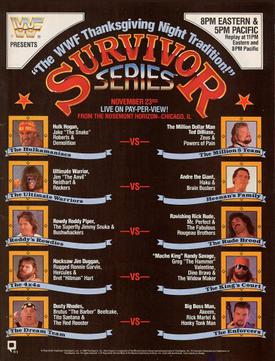
The 1989 Survivor Series was the third annual Survivor Series professional wrestling pay-per-view (PPV) event produced by the World Wrestling Federation. It took place on Thanksgiving Day on November 23, 1989, at the Rosemont Horizon in the Chicago suburb of Rosemont, Illinois.
The Twin Towers were a professional wrestling tag team in the World Wrestling Federation (WWF) from 1988 to 1990, consisting of Akeem and the Big Boss Man. They are best known for a main event feud with the Mega Powers.
The Colossal Connection was a professional wrestling tag team of André the Giant and Haku who competed in the World Wrestling Federation (WWF) in 1989 and 1990. The team was managed by Bobby Heenan and a part of the Heenan Family.

No Holds Barred: The Match/The Movie was a professional wrestling pay-per-view (PPV) event produced by the World Wrestling Federation. The program aired on December 27, 1989, and consisted of the film No Holds Barred in its entirety, followed by a match previously recorded at a Wrestling Challenge taping on December 12 at the Nashville Municipal Auditorium in Nashville, Tennessee. It was one of the few pay-per-view events not made available for streaming at the launch of WWE Network service, although in 2018, the cage match became available as part of the WWE Supertape compilation in the service's Classic Home Video section.

The André the Giant–Hulk Hogan rivalry was a professional wrestling rivalry between wrestlers André the Giant and Hulk Hogan that took place in the World Wrestling Federation.

The Wrestling Summit was a professional wrestling pay-per-view event that was produced and scripted collaboratively between the US-based World Wrestling Federation (WWF) and the Japanese All Japan Pro Wrestling (AJPW) and New Japan Pro-Wrestling (NJPW) promotions. The joint venture show took place on April 13, 1990 in the Tokyo Dome, in Tokyo, Japan and reportedly drew 53,742 spectators. The event was the only time the three promotions produced a joint show, although NJPW and WWF had previously worked together in the 1970s and '80s.




















